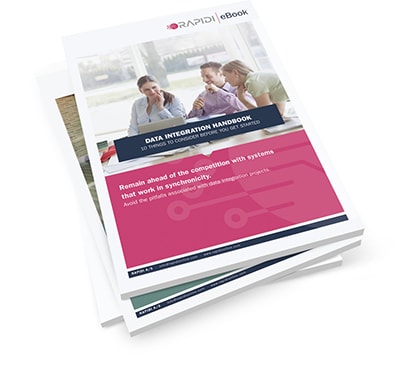As we become increasingly reliant on accurate data, keeping customer relationship management (CRM) systems clean and efficient is more important than ever.
The challenge lies not only in eradicating errors but in continuously nurturing the data's relevance and utility. As organizations expand, their CRM databases often become cluttered with outdated, redundant, or incorrect entries, impeding effective decision-making and operational efficiency.
This not only leads to inefficiencies but can also negatively impact your business decisions.
If your CRM system does not have updated information, your staff will not trust it. And if they do not trust it, they will not use it. Integrating your CRM with your ERP is a way to keep your data clean, current and up-to-date.
Today, many good integration solutions can be installed rapidly and at a reasonable price.
Generally, when investing in a CRM system like Salesforce or any other CRM system, you should not only think about what data you would like to get but also how to keep your data up to date.
Having a contact's name, e-mail and phone number and a link to the person's related company is common. But how about the social profile, birthday date, picture, title, additional prone numbers, special interests etc. The list is long, and if you keep adding details to your system, eventually, you will reach a point where it can no longer be maintained.
This article aims to provide a roadmap for untangling the complexities of CRM data cleansing, introducing five essential tips for integrating and managing your data more effectively.
These tips are designed to help you manage your CRM data more effectively, ensuring it remains accurate and useful for your business needs.
Keeping data clean and current is a challenge
How long do people, in general, stay in the same job or even within the same company? According to Forbes, the average worker today stays at each of their jobs for 4.4 years.
This is the current situation, and the future trend is that the expected tenure of the workforce's youngest employees is about half that, around two years.
According to Forbes, 91% of Millennials (born between 1977 and 1997) expect to stay in a job for less than three years, based on a survey of 1,189 employees and 150 managers.
This means that they would have 15 – 20 jobs throughout their working lives. This does not make the task of keeping data current easier. You need a detailed review of all of your contacts a minimum of once a year to have almost valid data, and this is just to have them linked to the right company (LinkedIn is a goldmine of information in that regard).
There can be many different data sources. For example, you can get new data by manually creating records with the risk of creating a doublet if you do not have very effective duplicate control.
If two companies merge, their customer databases will be merged into one database with the risk of having many duplicates or inconsistent data. There is always an intention to clean up later but it rarely happens. Doublets just add to the complexity, and there is more to the story.
For example, you may have created manually customers in both your ERP and CRM system.
Sometimes, your current data is just outdated and data cleansing (or cleaning) is vital before you do any type of data processing.
What is data cleaning?
Data cleaning, data cleansing, and data scrubbing are the same thing. They all refers to the act of finding and removing errors in data.
In that process, you identify unwanted data, and you can then replace, update, or delete the dirty or corrupted data. It ensures that the data you have in your database is correct, without any errors or corruptions.
You must regularly clean your data set because poor quality data or "dirty data" will inevitably lead to errors and ineffective processes in your company.
Many simple data cleaning techniques can help you start the data-cleaning process. For example, checking your data for extra spaces, updating upper/lower case inconsistencies, doing a spell check, or making sure you delete formatting when copying and pasting data.
These will get you started, but if you want to truly tackle this issue, follow these 5 data-scrubbing tips.
5 tips to keep your data clean and current
Integrating your systems can be a big step toward better data quality.
How can you integrate your ERP and CRM to secure the highest data quality in both systems? Here are a few recommendations
TIP #1: Have a clear data model in mind
Which data should be transferred? Which should remain in one system only? Leads and opportunities are fine in your CRM system; you can do all required reporting from there. There is no reason to pollute your ERP system with this information.
But, if you have existing prospects created as customers in your ERP, these should be moved to your CRM (unless they are there already).
Before spending time and money on comprehensive transfers, evaluate how valid the data is and if it represents a real asset for your company (data that has not been updated for several years is unlikely to make a difference).
If only a fraction of your data is relevant, then you can limit the transfer to this.
As a general rule:
- Leads: should be kept in CRM systems only.
- Customers: are relevant to have in your ERP and CRM system. Make sure they are integrated.
- Items and pricing: if you make quotes from your CRM, make sure that items and prices are synced.
- Sales and payment history: mainly, one-way transfer from ERP, so nothing to worry about.
Whether it should sync one way or the other (or both) depends on your business processes and in which system the data is born.
TIP #2: Clean data in the source system
If you have information in both ERP and CRM, for example, leads/prospects, then you should transfer the data to CRM, delete it from ERP, and do data cleansing of all these records in CRM.
When data is transferred you can match records by having a data loader search for a match on name, address, and phone or similar (whatever fits your data).
If you engage on this road, you need to have a plan for how to deal with duplicate records, what becomes the consolidated account, whether the data gets consolidated/merged, or if one of the records is just discarded.
TIP #3: Simplify
You don't need a hundred fields – often, people use ten fields, where seven are mandatory. The remaining three others carry a description and additional contact methods.
All other information is system-generated or linked to a contact. Focus on using data that can be updated automatically or via your normal workflows.
It's incredible how much relevant information you can extract from CRM because you have related information from the ERP system, such as sales history.
TIP #4: Integrate ERP and CRM
You can significantly increase efficiency by integrating CRM and ERP. This way you can eliminate double data entries, and master data can be synchronized automatically so that people have data they can trust.
For the sales and marketing people operating within CRM, getting sales and payment history in itself is a goldmine of information to make better decisions, create more specific marketing target groups, etc.
Missing data integration is a bottleneck for future growth. With sales and payment history and other relevant information coming from ERP, the Salesforce Einstein AI has access to an important source of information for predictive activity recommendations.
TIP #5: Use a tool or page views with workflow support to keep your data clean
Usually, ERP data is not “that dirty” unless the company has been through a merger or a similar process where databases have been merged and not cleaned up. The specific data needed to run an ERP is based on commercial relationships, so this type of data is typically kept clean.
But CRM is an entirely different matter. Even if you are a mid-sized company with 5,000 leads and thousands of customers and contacts, it is a full-time job to keep data clean, and there are good ways to simplify this.
Besides discipline, one of the simplest ways to do this is to create editable page views in the CRM where you filter on incomplete records and simply get a list.
If you use Salesforce.com, there are at least a couple of good tools on Salesforce AppExchange to automate data cleansing. It's also where you can find the Rapidi Data Integration Solution.
Data cleansing is often the first thing mentioned when we start talking about data quality, but frankly, it will be a never-ending maintenance. Good quality source data is crucial at all times, and has to be anchored in your work processes as a “data quality culture.”
Unless users commit to a high data quality, it will not happen. Don't be afraid to measure, reward and celebrate high data quality. Integrating your systems is the first step in the right direction - then you have cleaned the first data set.
Key Takeaways
Navigating the intricate process of CRM data cleansing is essential for both the marketing and sales teams to maximize efficiency and accuracy. The cleansing process involves identifying and rectifying issues such as duplicate contacts, outdated contact information, and inconsistent data formats.
This is vital for enhancing marketing efforts and the effectiveness of marketing campaigns.
Sales reps and marketing professionals often face challenges with manual data entry, leading to duplicate entries and human errors.
A standard process for maintaining a contact record in a consistent format is crucial. This not only streamlines the sales funnel but also aids in building accurate customer profiles and improving customer interactions.
Regular cleanup of CRM data, including updating postal addresses and refining mailing lists, is a critical step for maintaining data integrity. By doing this regularly, businesses can ensure that their list of contacts remains current and useful, ultimately supporting both sales and marketing efforts.
The ongoing process of data cleansing helps in identifying and resolving quality issues, thereby enhancing the overall effectiveness of CRM systems.
Integrating your systems is the first step in the right direction, as you need to plan what you want to integrate and with that, you are already forced to clean your first set of data.
Learn more about 10 things to consider before starting your data integration project, including data cleaning, in our Data Integration Handbook.

Frequently Asked Questions
Not sure how to handle your data integration project smoothly and easily?
Sign up for a demo where you can talk to one of our data integration experts on how best to handle your data integration challenges. We will discuss with you in further detail on best practices and how to do things in data integration most effectively and smoothly.











